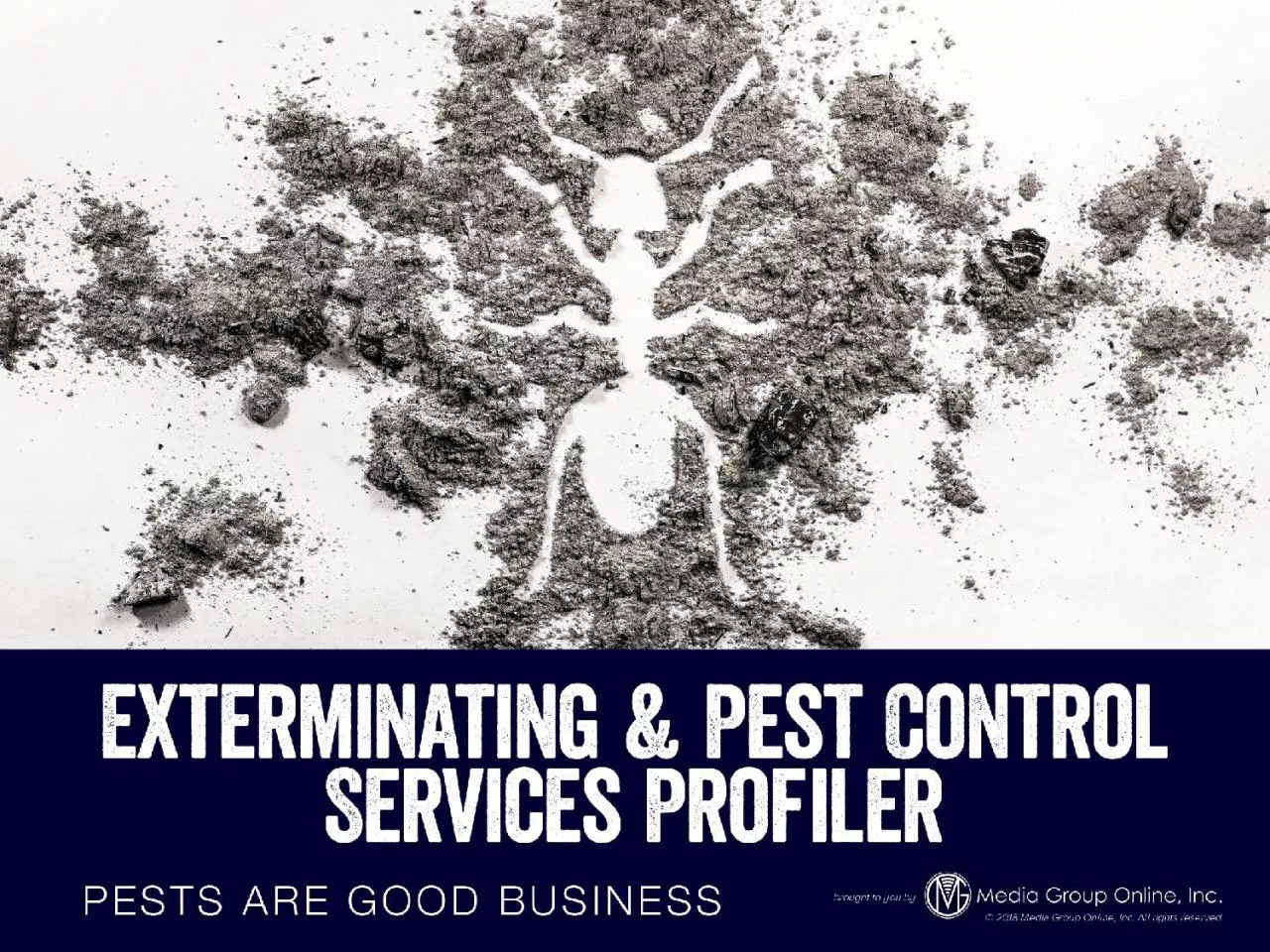

the US professional pest control industry generated 8175 billion in 2016 revenues a 46 increase over 2015 revenues There are approximately 19820 pest control firms in the US The increase was due to mild summer and winter weather which increased the incidents of insects and rodents Pest ID: 1039859
Download Presentation The PPT/PDF document "According to PCT ( Pest Control Techno..." is the property of its rightful owner. Permission is granted to download and print the materials on this web site for personal, non-commercial use only, and to display it on your personal computer provided you do not modify the materials and that you retain all copyright notices contained in the materials. By downloading content from our website, you accept the terms of this agreement.
1.
2. According to PCT (Pest Control Technology), the US professional pest control industry generated $8.175 billion in 2016 revenues, a 4.6% increase over 2015 revenues. There are approximately 19,820 pest control firms in the US.The increase was due to mild summer and winter weather, which increased the incidents of insects and rodents. Pest control companies also increased revenues by adding services, such as mosquito control.The global insect pest control market is forecasted to increase from $12.46 billion during 2016 to $17.3 billion by 2022, according to MarketsandMarkets research firm.More People, More Pests, More Profits
3. The National Pest Management Association (NPMA) forecasted that weather patterns, including regional flooding and extreme heat, will result in more ticks and mosquitos in addition to the usual fall pests, such as rodents, during fall/winter 2017-18.More than a quarter (28%) of post-construction termite jobs were done on buildings where no termites were present at the time of the treatment. An NPMA survey found that 37% of homeowners had seen a rodent in their home during the past year.Pest management professionals highlighted the following areas where they see revenue growth: bed bugs, mosquitos, bird/wildlife exclusion and cross-marketing to customers to inform them of their other services.Pests for All Seasons
4. Of the $8.175 billion in 2016 structural pest control market revenues, the top 100 pest control management companies accounted for 80.7% of the total, or $6.6 billion. Rollins retained its #1 position on the 2016 top 100 list, and had a 6% increase in revenues for 2016, to $1.573 billion. Terminix, #2 on the list again, also increased revenues by 6%, with $1.447 billion.Rentokil North America (#3) had the largest change in 2016 sales, increasing 36%, while Truly Nolen of America (#9) had the smallest, increasing 3%. Massey Services (#5) was forecast to have the largest sales increase for 2017, at 15%.Tops in Pest Control
5. In Professional Pest Management Alliance’s biannual Consumer Attitudes Survey for 2016, 78% of respondents agreed that pest control professionals protect public health and 80% said they protect homes and properties.Men were more likely to say that professional pest control companies are more effective than doing it yourself (77% compared to 61% of women). More men say they purchase pest control products to save money (30% compared to 23% of women).Homeowners age 25–44 were the most likely age group to think positively of pest control and 80% felt that pest control companies were more effective than DIY, compared to 60% of those 45–64 and 65+. Consumers of Pest Control Services
6. Almost one in five (19%) of pest control firms say they received somewhat or many more requests for green products than they did during 2016, and 79% have used natural products during the past year. Only 20% of the total products used are green.More than half, or 56%, use green products indoors and 38% use them outdoors. They are most often used for sensitive accounts, such as schools and hospitals, 68%; areas where food is handled or processed, 31%; and areas where food is grown, 29%.Ants are most commonly treated with natural products, 48%; followed by occasional invaders, 37%; cockroaches, 33%; bed bugs, 28%; spiders, 26%; and mosquitos, 19%.The “Greening” of Pest Control
7. The biggest challenge for pest control companies is finding good employees. In a PCT survey, 41% of respondents said their local area has a poor labor market, 34% said it was average and 9% said they have no problem finding qualified employees.The most difficult position to fill was service technicians, 57%; followed by salespeople, 11%; customer service, 3%; and middle management, 2%. A quarter of respondents (24%) said none of these.Almost two-thirds, or 62%, said labor costs increased and 46% said that the lack of qualified employees significantly hindered their company’s growth.In Search of Employees
8. Appeal to Millennials and Gen Xers by promoting eco-conscious products and services and instilling the consumer habit of contacting a professional instead of a DIY approach.Emphasize health risks, such as Zika virus and bed bugs, and position your company as a public health expert/solution provider.Emphasize the trustworthiness and reliability of your service technicians.Advertising Strategies
9. Post a pest trivia contest on Facebook to both educate and engage potential customers. Award one month of free service or a discount coupon to the first person or persons who provides the most correct answers.Publish video or written testimonials on your Website and social media accounts from customers stating the reliability and effectiveness of your services.Instruct your exterminators to photograph or video record especially egregious pest conditions in homes and businesses they visit and post them to your Website and social media pages to “scare” consumers into avoiding such infestations in their properties.New Media Strategies
10.